It looks like you're using an Ad Blocker.
Please white-list or disable AboveTopSecret.com in your ad-blocking tool.
Thank you.
Some features of ATS will be disabled while you continue to use an ad-blocker.
18
share:
Part 1: Brief introduction
Odin the allfather, Father of the gods, king of Asgard, ruler of Aesir, ravengod associated with war, battle, victory and death, but also wisdom, magic, poetry, prophecy, and the hunt. Odin’s name means the spirit.

The Valknut (slain warrior's knot) is a symbol associated with Odin. It consists of three interlaced triangles.


According to the Prose Edda, Odin was the first and most powerful of the Aesir, he was a son of Bestla and Borr and brother of Vili and Vé. With these brothers, he cast down the frost giant Ymir and made Earth from Ymir's body. The three brothers are often mentioned together. "Vili" is the German word for "will" (English), "Vé" is the German word (Gothic wai) for woe but is more likely related to the archaic German "Wei" meaning 'sacred.'
Odin has fathered numerous children. With his wife, Frigg, he fathered his doomed son Baldr and the blind god Höðr. By the personification of earth, Fjörgyn or Jörð, Odin was the father of his most famous son, Thor. By the giantess Gríðr, Odin was the father of Vídar, and by Rinda he was father of Váli. Also, many royal families claimed descent from Odin through other sons.
Odin had three residences in Asgard. First was Gladsheim, a vast hall where he presided over the twelve Diar or Judges, whom he had appointed to regulate the affairs of Asgard. Second, Valaskjálf, built of solid silver, in which there was an elevated place, Hlidskjalf, from his throne on which he could perceive all that passed throughout the whole earth. Third was Valhalla (the hall of the fallen), where Odin received the souls of the warriors killed in battle, called the Einherjar. The souls of women warriors, and those strong and beautiful women whom Odin favored, became Valkyries, who gather the souls of warriors fallen in battle (the Einherjar), as these would be needed to fight for him in the battle of Ragnarök. They took the souls of the warriors to Valhalla. Valhalla has five hundred and forty gates, and a vast hall of gold, hung around with golden shields, and spears and coats of mail. Valhalla got 540 gates and wide enough to let 800 warriors out of shoulder by shoulder. The roof is covered with golden shields.
Odin has a number of magical artifacts associated with him: the spear Gungnir, which never misses its target, when Odin throw this spear across the sky over a army that army is going to lose the battle. He got a magical gold ring (Draupnir), from which every ninth night eight new rings appear and he has two ravens Huginn and Muninn (Thought and Memory), who fly around Earth daily and report the happenings of the world to Odin in Valhalla at night. He also owned Sleipnir, an octopedal flying horse, who was given to Odin by Loki, he also got the severed head of Mímir, which foretold the future. He commands a pair of wolves named Geri and Freki, to whom he gives his food in Valhalla since he consumes nothing but mead or wine. From his throne, Hlidskjalf (located in Valaskjalf), Odin could see everything that occurred in the universe.
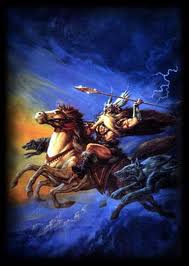
Odins Personality
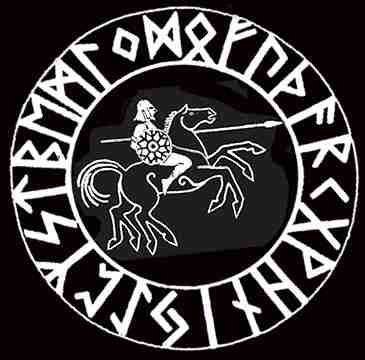
Odin is an ambivalent deity. Old Norse (Viking Age) connotations of Odin lie with "poetry, inspiration" as well as with "fury, madness and the wanderer." Odin sacrificed his right eye at Mímir's spring in order to gain the Wisdom of Ages. Odin gives to worthy poets the mead of inspiration, made by the dwarfs, from the vessel Óð-rœrir.
Odin also is associated with the concept of the Wild Hunt, a noisy, bellowing movement across the sky, leading a host of slain warriors.
He is a god of war, appearing throughout Norse myth as the bringer of victory. In the Norse sagas, Odin sometimes acts as the instigator of wars, and is said to have been able to start wars by simply throwing down his spear Gungnir, and/or sending his valkyries, to influence the battle toward the end that he desires. The Valkyries are Odin's beautiful battle maidens that went out to the fields of war to select and collect the worthy men who died in battle to come and sit at Odin's table in Valhalla, feasting and battling until they had to fight in the final battle, Ragnarök.
Odin is also associated with trickery, cunning, and deception. Most sagas have tales of Odin using his cunning to overcome adversaries and achieve his goals, such as swindling the blood of Kvasir from the dwarves.
Odin's personality and his interests are extremely complex. To simply call him All-Father, or a god war or wisdom is to completely misunderstand his various aspects and what he represents. Here is a god willing to sacrifice himself to himself, and hang from Yggdrasil for nine days to capture the knowledge of the runes. A god willing to sacrifice his eye for a drink from the Well of Mimir, and to gain knowledge of the future.
Odin walks among men, influencing them...sharing wisdom, bestowing victory...often disguised and hiding his true identity. Having seen the future, Odin always has an eye on the coming end, and prepares with some urgency for his role and the role of his armies in Ragnarok.
If you think a wise one-eyed Norse cowboy on an eight-legged horse would be easy to recognise, this isn't necessarily so for ODIN is a shape-changer, and his range of disguises make Sherlock Holmes look like Miss Marple. He also travels incognito under a variety of false names.
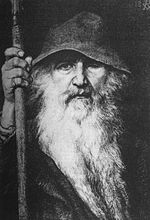
edit on 25-9-2011 by Mimir because: (no reason given)
Part 2: Stories about Odin
Time to introduce a few stories about Odin and how the sacrificial rite is linked to him. The following story about how Odin brought the mead is copy / paste to show you a full translated story from Edda and how they were written original but I'll start with a short story about Mimirs well.
Mimirs well
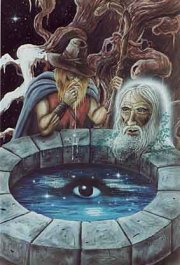
The old giant Mimir sits and guard hes well which lie at the roots of Yggdrasil in Jotunheim home of the giants. If you drink one sip of the water in the well, you will know all that happened in the past and will happen in the future. Mimir himself drinks from the well every day and therefore is the smartest of all.
One day Odins brothers Vile and Ve has disappeared and noone knows where they are. Odin visit Mimir and ask for permission to drink from the well. Mimir declines and Odin say that he is willing to pay anything as long as he’s allowed to drink. Mimir demands Odins right eye as payment which Odin pay, he pulls out hes eye and place it in the well, After this hes allowed to drink all he want.
At some point of time the Vanir cuts of the head of Mimir and sends it to Odin. Odin balsamate the severed head so he still can talk with it and get good advice. To perform this magic Odin use a magical spell song (Gjalresang). It is said that Odin knows atleast 18 spell songs. When performing this kind of magic your singing in a high pitched screaming voice, just like some witch doctors and shamanists do.
The offer rite
Living in the harsh north climate the old norse had to be on the good side with the gods. This included various sacrifices. They didn’t have churches or priests, so the local chieftain, earl or king had an additional job as “Gode” (sacrificial priest). Most blood sacrifice was animals, but occasionally humans were the sacrifice, it could be the first war-hostage or a slave (træl). The victim sometimes were hung from a tree after a horrifying murder. The blood was painted on the “gods house” and spayed upon the audience. Afterwards a feast with mead and wishes about better growth or luck of war was asked to the gods (we still drink “grave beers” after funeral’s in Denmark). At the beginning of spring, the end of the summer and at the middle of the winter people gathered to larger feasts with lot of mead and meat.
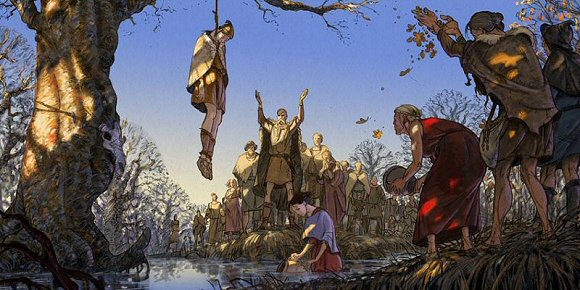
The historian Cornelius Tacitus wrote down a story he heard from tradesmen traveling northern Europe. They told about savage tribes to the north. Tacitus wrote “Traitors and deserters is hung from trees, cowards, pacifists, war-frightened and unnatural sex is punished with drowning in a bog”. Another place he wrote that germanic tribes used human sacrifice. Adam of Bremen also reports about humans and animals hanging from trees at the sacred fields near Uppsala.
One of the best kept bog mummies was found in Denmark and is named the Tollund man (Tollundmanden), who lived roughly 2300-2400 years ago.
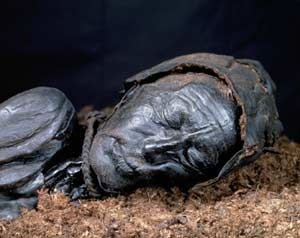
He was found in a bog near Silkeborg in 1950, with a rope around he’s neck and a ghostly peaceful sleeping position. Forensic medics believe he’s eyes and mouth was closed after he’s death. This indicates that he was sacrificed to the gods and not a criminal. He can be seen on Moesgård Museum near Aarhus who has a great presentation about him.
Even thou the gods was humanlike it was important not to forget they were gods. They had to be careful the gods didn’t get angry because that equaled trouble. The gods were strong and possessed supernatural powers, they did what they wanted to do and humans was dumb to get in their way. Instead humans always had to do their best to please the gods, bring sacrifices, gifts and feasts in their name of the god.
Hanging the sorceror (The self-sacrifice of Odin)

Hanging was an important religious practice among pagan communities long before christianity. It was considered an honor to be sacrificed to a god. Most pagan sacrifices found is a threefold slaughter, they would be strangled to honor Odin, then stabbed in the throat and finally “drowned” often on a swamp area. When you were dead they believed you would visit Hel who would decide if you should go to Valhalla or stay with Hel.
After Odin had observed how the witch goddess (Hel) hanging and burning from a tree cheated death, Odin decide this copy neat little trick to escape he’s fate that has been prophesied by the norns.
But before that Odin almost lose a war against the goddess, they reconcile, she move to Asgard where she teaches Odin her witchcraft. After a time they separate and starts teaching their followers the arts of magic, off cause Odin got a tough task convincing the other gods about this foul and unmanly weapon’s value.
For Odin’s initiation he need to self-sacrifice himself. Odin is the spirit and giver of breath and therefore he’s trial will be by strangulation. Odin doesn’t die, but he reaches a higher state of knowledge (awareness?) from he’s experience. He hang’s for 9 days, and have a near death experience. 9 is the number of the goddess Hel who also rules in 9 of the 12 worlds. These are the 9 worlds on the Lifetree Yggdrasil and 3 immortal worlds. It is the “daughters of Hel” and continuously bring souls to their mother.
Hanging on the tree Odin looks down at the root’s of the world tree and see the rune’s of destiny and 9 powerful spellsong’s which has been inscribed by the goddess of fate. Odin consume the knowledge of the runes in he’s soul and starts to spread he’s newfound wisdom as soon as he escapes Hel using these spellsongs.
Mock sacrifice in honor of Odin was a part of some pagan societies, like the Vikings of Upsala. The target would be mock hanged, stabbed and “starve” for 9 days.
HOW ODIN BROUGHT THE MEAD TO ASGARD
[36] BESIDES the gods who lived in Asgard and ruled over Midgard, the world of men, there were the Vans, who ruled the seas and the air. The greatest of these was Njord, who kept the winds in the hollow of his hand and vexed the seas with storms or spread over them the peace of a great calm. His son Frey sent rain and sunshine upon the earth and cared for the harvests, while his daughter Freyja was so full of love that she made the whole world beautiful with tenderness, and filled the hearts of men with the sweetest joys they ever knew.
[37] It happened almost at the beginning that the gods and the Vans went to war with each other, and long and fierce was the struggle between them. When peace was made at last, Njord, Frey, and Freyja found homes for themselves in Asgard, and henceforth they were all as one family.
While the council at which peace was made was being held, a great jar stood in the open space between the two parties, and when the meeting was over the gods were so glad to be rid of the troublesome war that they resolved to create something that should always remind them of the council. So they took the great jar and out of it they moulded the form of a man, and called him Kvaser.
Kvaser was grown up when he was born, and a wonderful man he was
[38] too. In all the world there was nobody so wise as he; ask him any question, and he could answer it. He knew how the gods lived, how the world was made, and what sort of places heaven and hell were. Kvaser was good, too, as all really wise men are. He was a great traveller, always going from place to place, and always welcome, because wherever he went he made men wiser and better. People sometimes think poets rather useless sort of men; but that was not the opinion of the gods, for when they made the first poet they made the very best man they could think of.
But poets cannot keep out of trouble any easier than other men, and sometimes not half so well. One night as Kvaser was travelling along through one of those deep
[39] valleys that run down to the sea in that country, he came to the house of two dwarfs with very queer names, Galar and Fjalar. They were not only little in size, but small and mean in nature, and like all other people of little nature, they were very envious and cruel, and they hated Kvaser because he was so much nobler than they. Galar had a dark, ugly face, which looked still uglier when he saw Kvaser coming towards the house.
"Fjalar! Fjalar!" he called out, "here comes the wise man who always talks in rhymes, and thinks he knows so much more than anybody else."
And when Fjalar saw the poet walking across the fields, a black shadow came over his face like a thunder-cloud. "Galar," he whis-
[40] pered, looking around to see that nobody could hear, "we've got him alone; let's kill him, and see how much good his wisdom will do him."
Meanwhile Kvaser was slowly approaching the house, and the sea, as it dashed against the rocks, was making a song in his mind. If you had heard him sing it, you would have heard the voices of the waves as they toss their white caps and chase each other foaming and roaring and tumbling on the beach. When Kvaser came up to the dwarfs they pretended to be very glad to see him, and told him he was the one person above all others they had wanted to see, because they had a question they had been waiting a long time to ask him. Kvaser was so noble himself that he never thought evil of any one, and when they asked him to
[41] go with them into a very dark and lonely part of the valley, so that nobody could hear their talk, he had no suspicion that they meant any harm; but no sooner had they come to the place than they struck him down from behind. Having killed him, they caught his blood in two jars and a kettle, and mixed it with honey, and so the wonderful mead as made. It took not only sweetness but life to make true poetry.
Not long after this Galar and Fjalar killed a giant named Gilling, and were punished for it too; for the giant's son, Suttung, when he discovered how his father had been put to death, took the dwarfs out to sea and put them on a little rocky island where they would certainly be drowned when the tide came in, and rowed off to leave them; but the rascals begged
[42] so hard to be taken off, he finally promised to let them live if they would give him the mead. Then Suttung took the mead home and put it in his cellar, and told his daughter Gunlad to watch it day and night, for he knew what a precious drink it was. So the mead passed out of the dwarfs' hands into the keeping of a giant.
Now the gods were very fond of Kvaser, and when a long time had passed without any word from him, they asked Galar and Fjalar if they knew anything about him, and the dwarfs said he had been choked by his own wisdom; but Odin knew that this was a false story. He kept his own counsel, and said nothing about what he was going to do, but one day the gods missed him, and knew he had gone on one of his long journeys.
[43] As he walked along nobody took him for a god; he looked like a very handsome labourer, and in fact that is what he really was. He had pretty much the whole world in his charge, and he had to work very hard to keep it in any kind of order. Words could hardly describe the beautiful country in which Odin took his way,—its deep, quiet green valleys, with the sparkling cold streams rushing through them; its steep mountains, crowned with fir and pine; its great crags standing out into the sea; and its fjords breaking the coast into numberless bays. Odin enjoyed it all, for the gods love beauty, but he was thinking all the time how he should get the mead out of the giant's cellar. He knew perfectly well that Suttung would never give it up willingly, and that he must get it either by force or by
[44] stratagem. Suttung was very strong, and the cellar was cut out of the solid rock; and the more Odin thought about it the harder it seemed to him. If he had been a man he would have given up, but that was not his way; besides, he had loved Kvaser, and the mead was his blood, and he meant to bring it to heaven.
Now Suttung had a brother named Bauge, who was a farmer, and one afternoon, as his nine thralls were mowing in the fields, they saw a stranger coming towards them. It was a very uncommon thing to see a stranger in that out-of-the-way place, and the men all stopped work to watch him. He was a farm labourer like themselves, but he was very large in stature, and had a very noble face and manner.
"A fine meadow of grass," he said
[45] in a deep musical voice as he joined them, "but you find it hard work; your scythes are dull."
They certainly did look tired and overworked.
"Hand me your scythes and I will whet them for you," continued the stranger. The thralls were very glad to have anybody do that for them, so they gave him their scythes without saying a word. In a moment the valley rang with the quick strokes of the stone on the hard metal, and the sparks flew in showers around them. The men had never seen such a whetting of scythes before, and their astonishment grew greater still when they found that the grass seemed to fall like magic before them. The mowing, which had been so hard, was now the easiest thing in the world.
[46] "Sell us the whetstone," they shouted, crowding around the stranger.
"Well," said he very coolly, "I will sell it, but I must have a good price for it."
Then each demanded it for himself, and while they were quarrelling as to which should have it, the stranger threw it high into the air, and bade them fight for it, which they did so fiercely that each slew his fellow with his scythe, and the stranger was left alone in the field. He threw the whetstone away, walked off, and as the sun was going down, came to the giant's house and asked if he might stay all night. Bauge was willing, as people were in those days, to give supper and a bed to the stranger, and asked him in.
After supper they talked together, and Bauge told the stranger that his
[47] nine thralls had been fighting in the field and had killed each other, and that he was in great trouble because he did not know where to get men to do his work.
"I'll do it," said the stranger.
"Yes," said Bauge, "but you are only one.
"That is true," he answered, "but try me and I'll do the work of all nine."
Bauge looked as if he didn't believe it, but it was one good man gained, at least, and that was something.
"What shall I pay you?" continued Bauge, determined to finish the bargain before the man had time to change his mind. The stranger thought a few moments as if he were uncertain what pay he wanted.
"I'll do the work," he said slowly,
, [48] at last, "if you will give me a drink of the mead in your brother's cellar." Bauge was very much surprised; he could not understand how the man knew anything about the mead. He was very sure, however, that Suttung would not give him a drop of it, and he thought it was a good chance to get his work done for nothing. "Well," said he, "I can't promise you that, for Suttung takes precious good care of the mead, but I will do what I can to help you get it."
So the bargain was made, and the next morning the stranger was at work; and all summer, early and late, he was in the fields doing the work of nine men. Bauge often wondered what kind of a man his new farm-hand was; but so long as the work was done he cared for nothing more, and he asked no ques-
[49] tions. The stranger once said his name was Bolverk, and that was all he ever said about himself. The months went by, winter came, the work was all done, and Bolverk demanded his pay.
"We'll go and ask my brother for it," said Bauge; so they both went to Suttung. Bauge told his brother the bargain he had made with his workman, and asked for a little of the mead.
"No" said Suttung very crossly, looking suspiciously at Bolverk; "it's no bargain of mine, and not a drop shall you have."
Bolverk seemed not at all surprised at his ill fortune, and Bauge thought that he had gotten his work done for nothing; but after they had gone a little way together and were hidden from the house by the trees,
[50] Bolverk drew out an auger from under his clothing.
"Bauge," said he, "you promised to help me get that mead. I am going into Suttung's cellar for it."
Bauge smiled at the idea of cutting through a thick rock and getting into the cellar with that auger, but when it was handed to him he took it without saying a word and began to bore. It was an astonishing auger, for no sooner had he pressed it against the rock than it began to fly around with wonderful rapidity, the chips of stone fairly making a cloud about him. Once he stopped, for he was afraid he really would get into the cellar, and told Bolverk he had bored through, but Bolverk knew that couldn't be true, because the chips still flew out, so he told Bauge to go on. In a little time the au-
[51] ger slipped through. Bauge looked around, but there was no Bolverk, and while he stared in every direction a large worm crept up the rock and into the hole. When Bauge caught sight of it he thrust the auger hastily into the hole, but Bolverk's voice answered back from the cellar, "Too late, Bauge; you needn't bore any longer."
Then Bauge suspected that a man who had done the work of nine men summer, and suddenly changed himself into a worm, must be somebody more than common. Bolverk was actually in Suttung's house, but how was he to get out again with the mead?
Gunlad, the young lady who had been charged by her father to watch the precious drink day and night, was sitting quietly beside it, when she
[52] was suddenly surprised, and not a little frightened, by the apparition of a young and beautiful man standing before her. What the handsome young man said to her nobody knows, but he probably told her he was very much exhausted, and hinted that she was very lovely; that he had never seen any one he admired so much before. At any rate, he persuaded her to let him drink three draughts of the mead, only three. They were certainly the most astonishing draughts anybody ever heard of, for with the first he emptied one jar, with the second he emptied the other jar, and with the third he finished the kettle.
And now another wonderful change took place. Bolverk had entered as a worm, but no sooner had he drunk the mead than in an instant he be-
[53] came an eagle, and before Gunlad knew what had happened, with splendid wings outspread he was rising upward in broad, easy flight. Through the still air, faster and faster, higher and higher, in wide circles that swept far round the summits of the mountains, in swift majestic flight he rose until the earth had vanished out of sight, and his mighty pinions beat against the gates of Asgard.
So Odin brought the mead to heaven, where it remains to this day, and only those whom the gods love are permitted to drink of it.
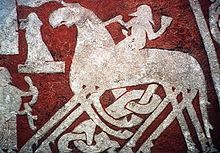
Santa Claus
Santa Claus, a jolly old fat man with a long white beard who is said to distribute presents to well-behaved children on Christmas Eve, is largely based on Odin, merged with the Christian legend of Saint Nicholas of Myra. Most Christmas traditions in Germanic countries derive from celebrations of the pagan winter solstice holiday Yule as a result of the gradual merging of the two holidays.
Odin was recorded as leading a great Yule hunting party through the sky. Two books from Iceland, the Poetic Edda, compiled in the 13th century from earlier sources, and the Prose Edda, written in the 13th century by Snorri Sturluson, describe Odin as riding an eight-legged horse named Sleipnir that could leap great distances, giving rise to comparisons to Santa Claus's reindeer.[19] Further, Odin was referred to by many names in Skaldic poetry, some of which describe his appearance or functions; these include Síðgrani, Síðskeggr, Langbarðr, (all meaning "long beard") and Jólnir[23] ("Yule figure").
According to Phyllis Siefker, children would place their boots, filled with carrots, straw, or sugar, near the chimney for Odin's flying horse, Sleipnir, to eat. Odin would then reward those children for their kindness by replacing Sleipnir's food with gifts or candy. This practice, she claims, survived in Germany, Belgium, and the Netherlands after the adoption of Christianity and became associated with Saint Nicholas as a result of the process of Christianization and can be still seen in the modern practice of the hanging of stockings at the chimney in some homes.

This ends the brief introduction to Odin, feel free to add more stories about him to this thread if you got some. In part 4 I will introduce you to Thor if this series continues.

Odin’s song (English version, annoying voice)
edit on 25-9-2011 by Mimir because: (no reason given)
Part 3: Questions about Odin for Ancient alien believers
Is Sleipnir, the ravens and wolfs chimeras?
Or could Sleipnir be a weird UFO?
Is Odin’s spear Gungnir a alien weapon technology? (The spear never misses it’s target and always return to Odins hand when thrown, it can also change the winds of war)
Is the well of Mimir the inspiration to the Holy Grail? (Well of knowledge)
Is the magical gold ring Draupnir an elemental copy-machine? (It copy itself at a set timeframe)
Is Odin’s throne some kind of “gateway” to a higher state of mind or a connection to an alien super computer? (From the throne he can see everything that currently occur in the universe)
Is the symbol of Odin tied to the pyramids in Giza? (theres 3 of them too)
Could Odins all-seing eye be linked to the eye of Horus?
Is santa claus really Odin?
Is the biblical figure "Jesus" a rip off clone of the real god Odin? (To make a easyer read and understandable mythology, with one God, making it easyer to control and manipulate the people)
...Find more question yourself
Norse mythology part 1 - The creation of the world and universe
Norse Mythology part 2 – The races, gods and their home
aerenlund.dk
hvad er nordisk mytologi
godchecker.com
mainlesson.com
Wiki
edit on 25-9-2011 by Mimir because: (no reason given)
reply to post by Mimir
I would love to answer your questions but time is not my ally, what is the question you would like an answer to the most? I will do my best to answer quickly
I would love to answer your questions but time is not my ally, what is the question you would like an answer to the most? I will do my best to answer quickly
reply to post by GuardianCommanderOdin
There is a book on Google Books called The pedigree and history of the Washington family: derived from Odin, the Founder of Scandanavia
[It is downloadable, found at books.google.com...]< br />
It claims that it is a 'legal' genealogy of George Washington traced back to Odin. Written by Albert Welles, President of the American College for Genealogical Registry and Heraldry in 1879.
A quote from the preface of the book (I can't seem to paste it) "This reference can be true of one people , the Norsemen, the dwellers in Scandinavia... conquered England, Scotland and Ireland, ravaged Brittany and Normandy, discovered and colonized Iceland and Greenland, and
CROSSED THE ATLANTIC IN THEIR CRAZY BARKS AND DISCOVERED THIS VERY CONTINENT LONG BEFORE COLUMBUS; ANCHORED IN VINELAND SOUND AND LEFT A MONUMENT BEHIND THEM.
Just recently we have "found' this to be true.
Further it goes on:
All the ancient traditions of the North agree in describing the first inhabitants of Scandinavia as men of colossal stature and incredible strength. THESE GIANTS (OR TROLLS AS THEY WERE CALLED BY THE EDDAS) WERE ALLEGED TO HAVE BEEN A REMNANT OF THE CANAANITISH ANAKIM (DESCENDANTS OF ANEK, DERIVED FROM CANAAN, THE SON OF HAM THE SON OF NOAH), WHOM CALEB AND JOSHUA, BY DIVINE COMMAND, DROVE OUT OF PALESTINE, AND WHO ULTIMATELY SETTLED IN SCANDIA AFTER FIGHTING MANY BATTLES WITH THE SCYTHIAN EMIGRANTS FROM ASIA.
There is a book on Google Books called The pedigree and history of the Washington family: derived from Odin, the Founder of Scandanavia
[It is downloadable, found at books.google.com...]< br />
It claims that it is a 'legal' genealogy of George Washington traced back to Odin. Written by Albert Welles, President of the American College for Genealogical Registry and Heraldry in 1879.
A quote from the preface of the book (I can't seem to paste it) "This reference can be true of one people , the Norsemen, the dwellers in Scandinavia... conquered England, Scotland and Ireland, ravaged Brittany and Normandy, discovered and colonized Iceland and Greenland, and
CROSSED THE ATLANTIC IN THEIR CRAZY BARKS AND DISCOVERED THIS VERY CONTINENT LONG BEFORE COLUMBUS; ANCHORED IN VINELAND SOUND AND LEFT A MONUMENT BEHIND THEM.
Just recently we have "found' this to be true.
Further it goes on:
All the ancient traditions of the North agree in describing the first inhabitants of Scandinavia as men of colossal stature and incredible strength. THESE GIANTS (OR TROLLS AS THEY WERE CALLED BY THE EDDAS) WERE ALLEGED TO HAVE BEEN A REMNANT OF THE CANAANITISH ANAKIM (DESCENDANTS OF ANEK, DERIVED FROM CANAAN, THE SON OF HAM THE SON OF NOAH), WHOM CALEB AND JOSHUA, BY DIVINE COMMAND, DROVE OUT OF PALESTINE, AND WHO ULTIMATELY SETTLED IN SCANDIA AFTER FIGHTING MANY BATTLES WITH THE SCYTHIAN EMIGRANTS FROM ASIA.
reply to post by GuardianCommanderOdin
Of course the aforementioned book gives the genealogy of George Washington back to Odin.
Of course the aforementioned book gives the genealogy of George Washington back to Odin.
reply to post by Mimir
Question: Is Odin (the mercurial, one-eyed, earth-wandering, disguise-donning, ring-bearing, crow and wolf accompanying, sorcery-practicing, god of war) actually Satan/Saturn/Cronus?
Odin is doomed to lose to Surtr in the final battle of Ragnarok.
What is your take on Surtr being a cognate of Jesus/Shiva? On the Aesir as Asuras and on the Vanir as the Devas?
Question: Is Odin (the mercurial, one-eyed, earth-wandering, disguise-donning, ring-bearing, crow and wolf accompanying, sorcery-practicing, god of war) actually Satan/Saturn/Cronus?
Odin is doomed to lose to Surtr in the final battle of Ragnarok.
What is your take on Surtr being a cognate of Jesus/Shiva? On the Aesir as Asuras and on the Vanir as the Devas?
edit on 23-11-2012 by Aesir26
because: (no reason given)
reply to post by Mimir
Possible link with Satan Claws.
Odin was the fallen seraph named Azazel.
Throughout history Azazel has been know as Uzazel, Uzza and Oz. Hence the circular celtic cross with the plus sign in the centre was in worship to Oz. Each quarter in the circle is a season of the year. This also relates to the circle of life which is exactly what a pagan demi-god would promote.
By the way, Thor is Shemehaza or one of the (fallen watchers) Iyram.
Notice how Thor used a Hammer of Thunderbolts and Zeus used lightning as his main weapon.
This is because both Thor and Zeus are the same fallen watcher - Shemehaza, dating back to the days of Enoch the Scribe.
Is santa claus really Odin?
Possible link with Satan Claws.
Is the biblical figure "Jesus" a rip off clone of the real god Odin?
Odin was the fallen seraph named Azazel.
Throughout history Azazel has been know as Uzazel, Uzza and Oz. Hence the circular celtic cross with the plus sign in the centre was in worship to Oz. Each quarter in the circle is a season of the year. This also relates to the circle of life which is exactly what a pagan demi-god would promote.
By the way, Thor is Shemehaza or one of the (fallen watchers) Iyram.
Notice how Thor used a Hammer of Thunderbolts and Zeus used lightning as his main weapon.
This is because both Thor and Zeus are the same fallen watcher - Shemehaza, dating back to the days of Enoch the Scribe.
reply to post by Aesir26
Do you see Surt(r) then being Jesus?
Sorry, i have never heard of the name Surt so i cannot answer.
edit on 23-11-2012 by Rapha because: (no reason given)
Originally posted by Aesir26
reply to post by Mimir
Question: Is Odin (the mercurial, one-eyed, earth-wandering, disguise-donning, ring-bearing, crow and wolf accompanying, sorcery-practicing, god of war) actually Satan/Saturn/Cronus?
The analogy has historically made with Mercury. Tacitus makes the connection very early on, comparing the (unique) nature of sacrifice to both gods. Also, a function of Odin that's not really touched on in this thread, is that of psychopomp, a function that also relates to Mercury. Also, Mercury is related to travelling and as much as Odin is related to wandering.
On the Aesir as Asuras and on the Vanir as the Devas?
Also, I'm under the impression that the traditional division amongst Asatru &c between Aesir and Vanir no longer really holds. Rudolf Simek's persuasively argues that this division is an artificial one based on reading too much into what a phrase Sturluson uses. It's worth noting that whilst A-S and Germanic analogues abound within Norse mythology and religion, the Aesir and Vanir division didn't really exist as such. This means it didn't exist earlier on and is a later development (and is possibly even a post-Conversion add-on) or that the division didn't exist at all.
edit on
23-11-2012 by Merriman Weir because: .
edit on 23-11-2012 by Merriman Weir because: .
Originally posted by Rapha
Odin was the fallen seraph named Azazel.
Throughout history Azazel has been know as Uzazel, Uzza and Oz. Hence the circular celtic cross with the plus sign in the centre was in worship to Oz. Each quarter in the circle is a season of the year. This also relates to the circle of life which is exactly what a pagan demi-god would promote.
By the way, Thor is Shemehaza or one of the (fallen watchers) Iyram.
Notice how Thor used a Hammer of Thunderbolts and Zeus used lightning as his main weapon.
This is because both Thor and Zeus are the same fallen watcher - Shemehaza, dating back to the days of Enoch the Scribe.
From where do you get these connections? Do you have any texts or citations?
reply to post by ImperialEmperorClaudius
I too have heard these theories from a VERY "born-again" Christian.
I too have heard these theories from a VERY "born-again" Christian.
new topics
-
God's Righteousness is Greater than Our Wrath
Religion, Faith, And Theology: 1 hours ago -
Electrical tricks for saving money
Education and Media: 4 hours ago -
VP's Secret Service agent brawls with other agents at Andrews
Mainstream News: 5 hours ago -
Sunak spinning the sickness figures
Other Current Events: 6 hours ago -
Nearly 70% Of Americans Want Talks To End War In Ukraine
Political Issues: 6 hours ago -
Late Night with the Devil - a really good unusual modern horror film.
Movies: 8 hours ago -
Cats Used as Live Bait to Train Ferocious Pitbulls in Illegal NYC Dogfighting
Social Issues and Civil Unrest: 9 hours ago -
The Good News According to Jesus - Episode 1
Religion, Faith, And Theology: 11 hours ago
top topics
-
Florida man's trip overseas ends in shock over $143,000 T-Mobile phone bill
Social Issues and Civil Unrest: 16 hours ago, 8 flags -
Cats Used as Live Bait to Train Ferocious Pitbulls in Illegal NYC Dogfighting
Social Issues and Civil Unrest: 9 hours ago, 8 flags -
VP's Secret Service agent brawls with other agents at Andrews
Mainstream News: 5 hours ago, 8 flags -
Bobiverse
Fantasy & Science Fiction: 16 hours ago, 3 flags -
HORRIBLE !! Russian Soldier Drinking Own Urine To Survive In Battle
World War Three: 13 hours ago, 3 flags -
Electrical tricks for saving money
Education and Media: 4 hours ago, 3 flags -
Nearly 70% Of Americans Want Talks To End War In Ukraine
Political Issues: 6 hours ago, 3 flags -
Sunak spinning the sickness figures
Other Current Events: 6 hours ago, 3 flags -
Late Night with the Devil - a really good unusual modern horror film.
Movies: 8 hours ago, 2 flags -
The Good News According to Jesus - Episode 1
Religion, Faith, And Theology: 11 hours ago, 1 flags
active topics
-
VP's Secret Service agent brawls with other agents at Andrews
Mainstream News • 37 • : SchrodingersRat -
New whistleblower Jason Sands speaks on Twitter Spaces last night.
Aliens and UFOs • 54 • : Ophiuchus1 -
DONALD J. TRUMP - 2024 Candidate for President - His Communications to Americans and the World.
2024 Elections • 514 • : WeMustCare -
The Acronym Game .. Pt.3
General Chit Chat • 7744 • : bally001 -
Truth Social goes public, be careful not to lose your money
Mainstream News • 128 • : Astyanax -
Sunak spinning the sickness figures
Other Current Events • 5 • : glen200376 -
SETI chief says US has no evidence for alien technology. 'And we never have'
Aliens and UFOs • 44 • : MikeDeGrasseTyson -
HORRIBLE !! Russian Soldier Drinking Own Urine To Survive In Battle
World War Three • 31 • : budzprime69 -
How ageing is" immune deficiency"
Medical Issues & Conspiracies • 33 • : rickymouse -
The Reality of the Laser
Military Projects • 46 • : Zaphod58
18
